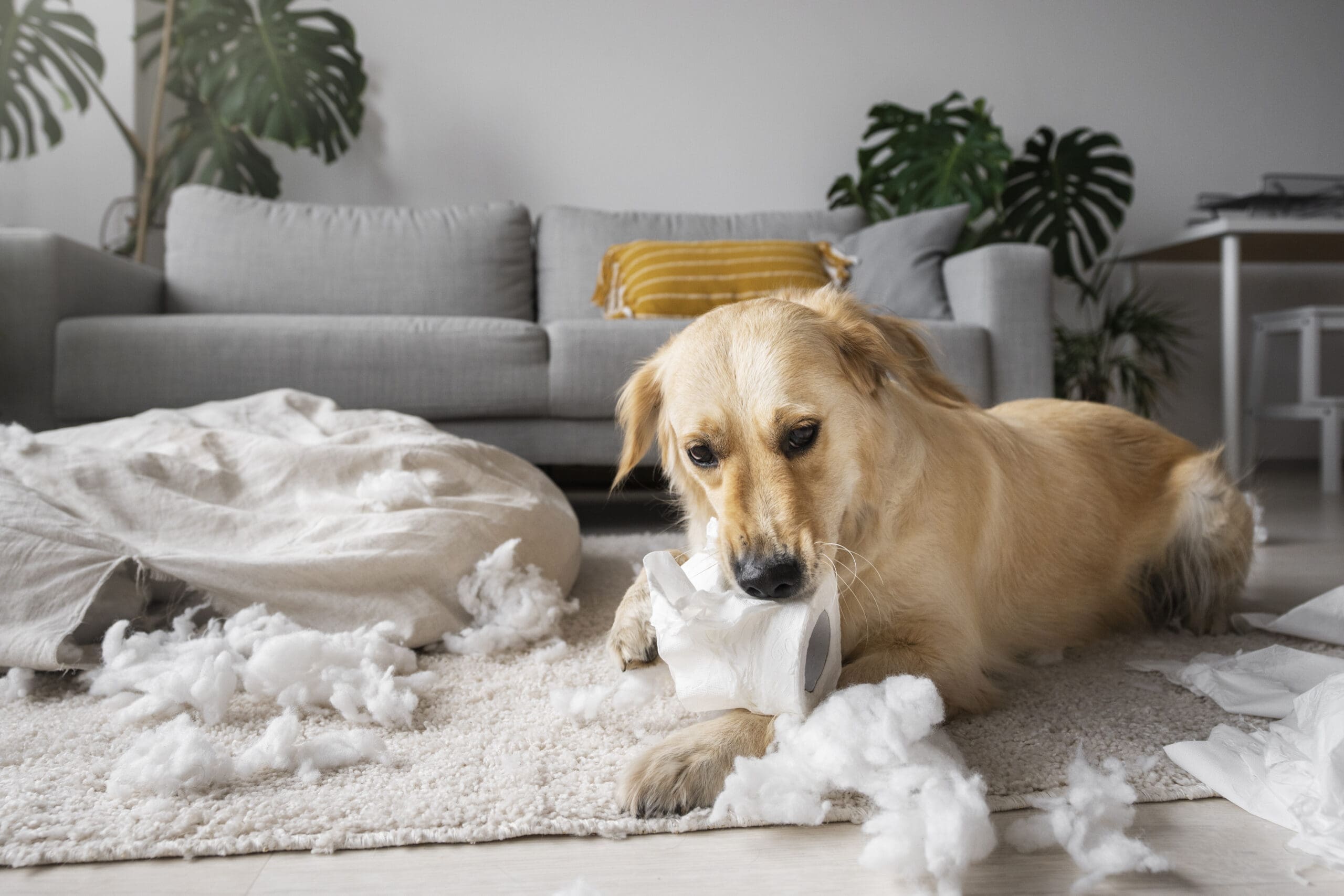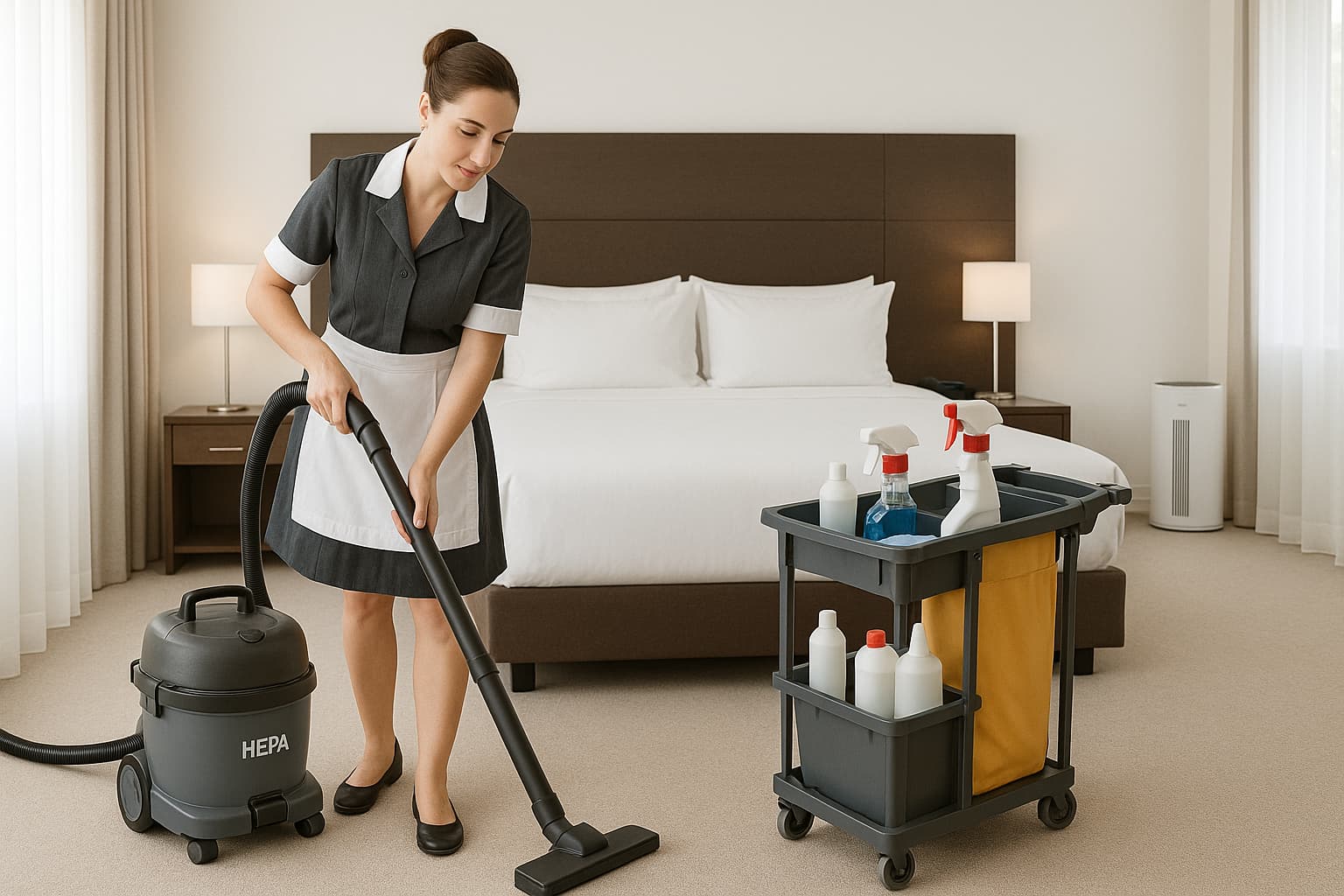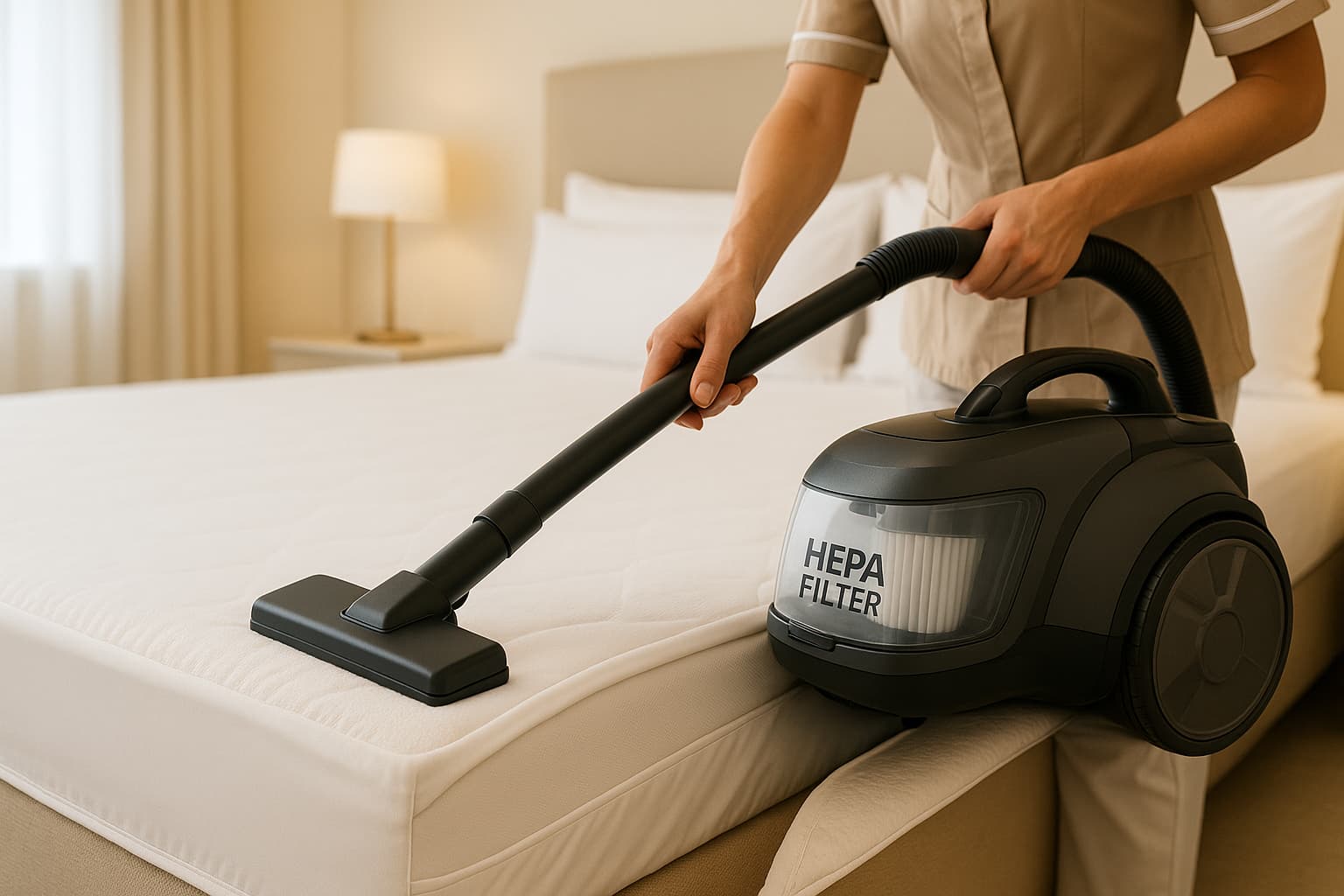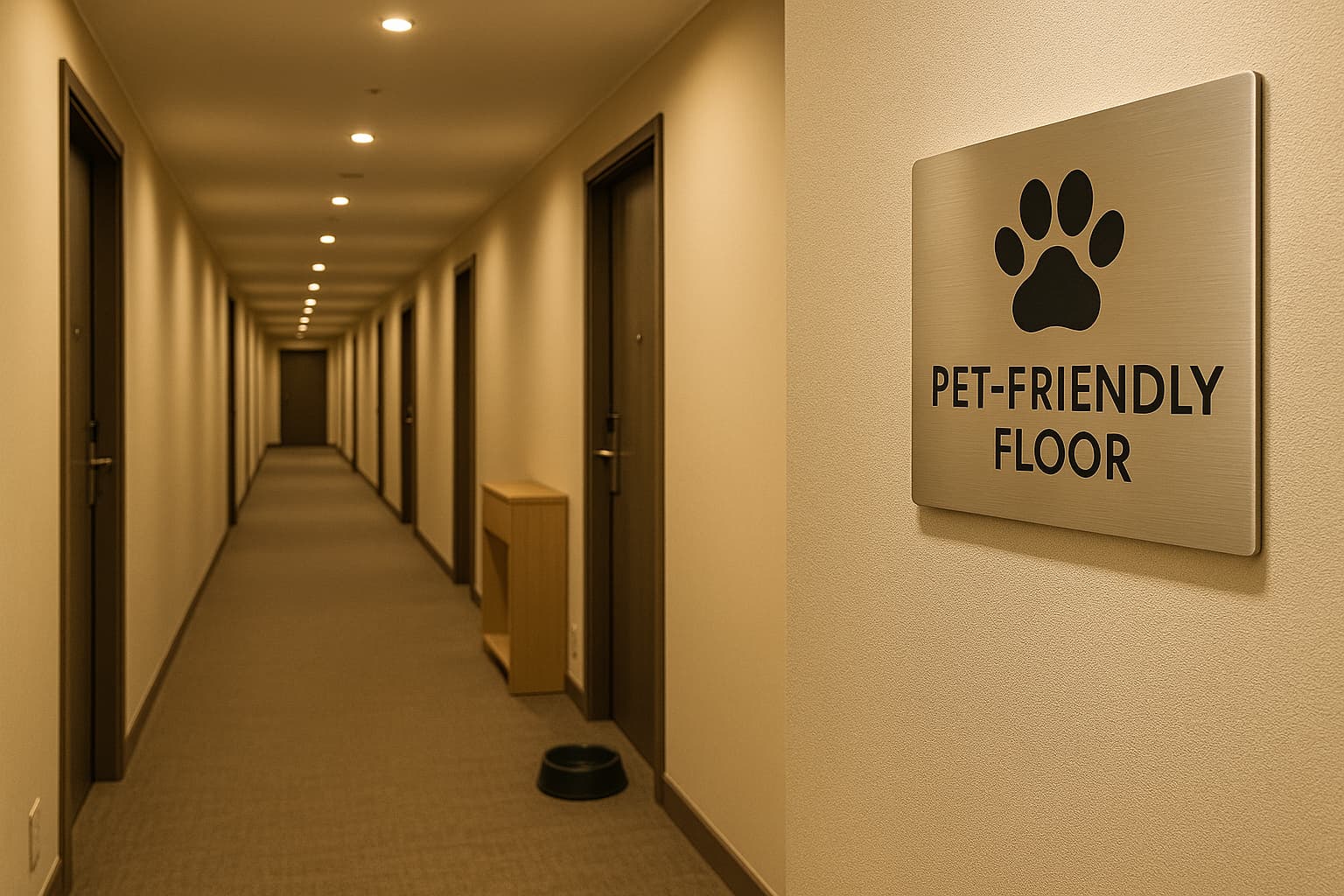Pet allergies affect approximately 10-20% of the global population, yet millions of people travel with dogs each year. Whether you’re a dog owner concerned about allergies in hotel rooms, a hotel manager looking to balance pet-friendly policies with allergy sufferer needs, or an allergy sufferer who occasionally encounters pet dander in accommodations, understanding how to manage pet allergens in hotel environments is essential for comfortable, safe travel.
Table of Contents
ToggleUnderstanding Pet Allergies: The Science Behind the Sneeze
What Causes Pet Allergies?
Contrary to popular belief, pet allergies aren’t caused by dog hair itself. The culprits are proteins found in:
- Dander: Microscopic flakes of dead skin cells (primary allergen)
- Saliva: Transferred to fur through grooming and licking
- Urine: Contains allergenic proteins that can become airborne
- Sebaceous glands: Oils in the skin containing allergenic proteins
These proteins are remarkably persistent and sticky, clinging to surfaces, fabrics, and even floating in the air for extended periods. The major dog allergen, Can f 1, can remain detectable in environments for months after a dog has left, making thorough cleaning essential in hotel settings.
Common Allergic Reactions
Pet allergy symptoms range from mild to severe:
- Respiratory: Sneezing, runny or stuffy nose, coughing, wheezing
- Eye-related: Itchy, red, watery eyes
- Skin reactions: Hives, eczema flare-ups, itching
- Asthma exacerbation: Difficulty breathing, chest tightness
- Severe reactions: Rare but possible anaphylaxis in extreme cases
Symptoms can appear immediately upon exposure or develop over several hours, complicating the identification of triggers in hotel environments.
The Challenge of Pet-Friendly Hotels
Balancing Inclusivity with Comfort
Hotels face a genuine dilemma: pet-friendly policies attract a growing, lucrative market segment, but inadequate allergen management can create serious problems for allergy-sensitive guests. The solution isn’t choosing between these groups, it’s implementing rigorous cleaning protocols that allow both populations to coexist comfortably.
Current Industry Standards
Pet-friendly hotel practices vary dramatically:
- Designated pet rooms: Some hotels restrict pets to specific rooms, protecting other inventory
- Enhanced cleaning protocols: Additional cleaning steps for rooms after pet stays
- Pet-free floors: Entire floors designated as pet-free zones
- Allergy-friendly room options: Specially maintained rooms with enhanced air filtration
- Variable policies: Many hotels lack standardized allergen management procedures
The inconsistency in standards means travelers must actively research and communicate their needs rather than assuming any level of allergen control.
Essential Cleaning Protocols for Managing Pet Allergens
Why Standard Cleaning Isn’t Enough
Regular housekeeping focuses on visible cleanliness and basic sanitization, but pet allergens require specialized attention:
- Microscopic size: Dander particles are too small to see with the naked eye
- Static cling: Allergens electrostatically bind to fabrics and surfaces
- Airborne persistence: Particles remain suspended in air for hours
- Hidden accumulation: Allergens settle in hard-to-reach areas like air vents and under furniture
Comprehensive Allergen Removal Process
Effective pet allergen elimination requires a systematic, multi-step approach:
Step 1: Air Quality Management
- Open windows to ventilate the room thoroughly
- Run HVAC system on high for 30+ minutes before cleaning
- Replace or clean air filters between pet and non-pet guests
- Use HEPA air purifiers during and after cleaning
- Allow minimum 6-8 hours of air exchange before non-pet guests
Step 2: Fabric Deep Cleaning
Fabrics are the primary reservoir for pet allergens:
- Bedding: Hot water wash (minimum 140°F/60°C) for all linens, blankets, pillows
- Curtains: Steam clean or launder if pet contact occurred
- Upholstery: Professional-grade steam cleaning with allergen-neutralizing solutions
- Carpets: Hot water extraction (steam cleaning) with multiple passes
- Mattresses: Vacuum with HEPA filter, then encase in allergen-proof covers
Step 3: Hard Surface Decontamination
- Damp-wipe all surfaces (prevents allergen dispersal into air)
- Use allergen-neutralizing cleaning solutions
- Pay special attention to pet-height surfaces (furniture legs, lower walls)
- Clean light switches, door handles, and remote controls
- Vacuum baseboards and corners with HEPA-filtered vacuum
Step 4: Hidden Areas
Allergens accumulate where standard cleaning often misses:
- Air vent covers and returns (remove and wash)
- Behind and under furniture (move and clean thoroughly)
- Window sills and tracks
- Lamp shades and ceiling fan blades
- Inside closets and drawers pets may have accessed
Step 5: Final Verification
- Final HEPA vacuuming of all surfaces
- Allergen test strips to verify reduction (available commercially)
- Fresh air filtration for minimum 4-6 hours
- Quality inspection by trained staff
Guide for Dog Owners: Minimizing Allergen Spread in Hotels
Responsible pet owners can significantly reduce allergen contamination:
Before Your Hotel Stay
Pre-trip grooming:
- Bathe your dog 24-48 hours before travel
- Brush thoroughly to remove loose fur and dander
- Trim nails to minimize fabric snagging and damage
- Consider professional grooming for heavy shedders
Pack strategically:
- Bring your dog’s own bedding and blankets
- Pack lint rollers and pet hair removal tools
- Include your own vacuum if staying extended periods
- Bring cleaning wipes for quick clean-ups
During Your Stay
Containment strategies:
- Keep your dog off hotel bedding (use brought bedding on floor)
- Cover furniture where your dog will sit with your own blankets
- Restrict access to carpeted areas when possible
- Wipe paws before entering after walks
- Brush your dog outside or in bathroom (easier to clean)
Daily maintenance:
- Daily vacuuming of obvious fur accumulation
- Damp-wipe surfaces your dog touches
- Keep dog’s belongings contained in one area
- Dispose of waste properly and immediately
- Air out the room daily
Before Checkout
Leave the room cleaner than required:
- Remove all visible pet hair with lint rollers
- Vacuum carpeted areas and upholstered furniture
- Wipe down surfaces your dog touched
- Strip bed linens (even if you didn’t use hotel bedding)
- Report any accidents or damage immediately
- Dispose of all pet waste and used supplies
- Open windows for air circulation
Taking these extra steps not only shows consideration for future guests but also helps maintain positive pet-friendly policies at hotels.
Protecting Yourself when Booking Hotels
Pre-Booking Research
Questions to ask hotels:
- My child has a pet allergy, do you have designated pet-free rooms or floors?
- What is your allergen cleaning protocol after pet stays?
- How long between a pet checkout and allergy-sensitive guest check-in?
- Do you have air purifiers available for rooms?
- Can you guarantee the room hasn’t hosted pets recently?
- Are hypoallergenic bedding options available?
Red flags to watch for:
- Hotels that can’t answer allergen protocol questions
- Properties that mix pet and non-pet rooms throughout
- Facilities with carpet throughout (harder to deep clean)
- Hotels unwilling to accommodate special cleaning requests
Room Inspection Upon Arrival
Don’t unpack until you’ve checked for allergens:
- Visual inspection: Look for visible pet hair on furniture, carpet, bedding
- Smell test: Pet odors often indicate inadequate cleaning
- Surface check: Run hands over upholstery to feel for embedded hair
- Air quality: Notice any stuffiness or pet-related scents
- Corners and edges: Check baseboards, under furniture for hair accumulation
If you find evidence of pets:
- Request immediate room change before unpacking
- Ask for a room far from pet-designated areas
- Document issues with photos if hotel disputes the problem
- Don’t accept assurances without verification—inspect the new room
Creating an Allergen-Reduced Environment
Even in clean rooms, take additional precautions:
- Bring a portable HEPA air purifier: Run continuously during your stay
- Use allergen-proof bedding covers: Encase hotel pillows and mattress
- Minimize fabric contact: Keep luggage off carpet, use luggage racks
- Wipe surfaces yourself: Damp-wipe high-touch areas with your own cleaning supplies
- Run air conditioning/heating: Circulate air with windows closed initially
- Remove unnecessary fabrics: Store extra pillows, blankets in closets
Medication and Emergency Planning
Prepare your allergy management kit:
- Antihistamines (both fast-acting and 24-hour varieties)
- Nasal corticosteroid spray
- Eye drops for allergic conjunctivitis
- Asthma inhaler if you have asthma
- Emergency epinephrine if you have severe reactions
- Local pharmacy locations identified in advance
Know when to seek help:
- Difficulty breathing or wheezing that doesn’t improve with medication
- Swelling of face, lips, or tongue
- Severe skin reactions or hives covering large areas
- Symptoms that significantly worsen despite medication
Implementing Effective Pet-Friendly Policies
Room designation strategy:
- Option 1: Dedicated pet wings or floors with enhanced ventilation systems
- Option 2: Permanent pet-only rooms that rotate out of general inventory
- Option 3: Mixed inventory with mandatory 48-hour buffer + deep cleaning
- Option 4: Separate buildings for pet and non-pet accommodations
Communication protocols:
- Clear disclosure of pet policies on all booking platforms
- Ask about allergies during reservation process
- Flag allergy-sensitive guests in booking systems
- Provide written allergen management procedures to guests who request them
- Train front desk staff to handle allergy-related requests professionally
Staff Training Requirements
All housekeeping and front desk staff should understand:
- The difference between standard cleaning and allergen removal
- Proper use of HEPA vacuums and allergen-neutralizing products
- How to identify rooms requiring enhanced cleaning
- Communication protocols when guests report allergen issues
- Emergency procedures for severe allergic reactions
Investment in Appropriate Equipment
Essential tools for proper allergen management:
- HEPA vacuum cleaners: Minimum 99.97% particle capture efficiency
- Steam cleaners: High-temperature units for fabric deep cleaning
- Air purifiers: Available for guest rooms upon request
- Allergen-neutralizing solutions: Enzymatic cleaners that break down proteins
- Allergen test kits: To verify cleaning effectiveness
- Protective equipment: For staff handling heavily contaminated items
Legal and Liability Considerations
Hotel Responsibilities
While hotels aren’t legally required to be allergen-free, they do have responsibilities:
- Accurate disclosure: Must truthfully represent room status (pet vs. non-pet)
- Reasonable accommodation: Must make good-faith efforts to honor allergy requests
- Negligence liability: Could be liable if aware of allergen issues and don’t address them
- Medical emergency response: Must have protocols for severe allergic reactions
Guest Responsibilities
Allergy sufferers should:
- Disclose allergies when booking (not hotel’s duty to ask)
- Request specific accommodations in advance
- Inspect rooms and report issues immediately
- Carry appropriate medication for known allergies
Pet owners should:
- Follow all posted pet policies and restrictions
- Report any accidents or damages honestly
- Accept liability for extraordinary cleaning costs if appropriate
- Maintain control of pets to prevent allergen spread
Future Innovations in Allergen Management
Emerging technologies promise better solutions:
Advanced Air Purification
- UV-C sterilization: Kills allergen-carrying particles in air
- Ionization technology: Causes allergens to fall from air for easier removal
- Photocatalytic oxidation: Breaks down allergen proteins at molecular level
- Smart air quality monitoring: Real-time allergen level detection and response
Surface Treatment Innovations
- Anti-allergen coatings: Preventive treatments for fabrics and surfaces
- Self-cleaning fabrics: Materials that resist allergen binding
- Antimicrobial surfaces: Prevent allergen protein preservation
- Nano-filtration materials: Bedding and upholstery that block allergens
Detection and Verification
- Rapid allergen test kits: Immediate verification of cleaning effectiveness
- Digital allergen sensors: Continuous monitoring of room allergen levels
- Blockchain verification: Immutable records of cleaning protocols executed
- Guest-facing allergen data: Real-time allergen level displays in rooms
Practical Checklist for All Parties
For Dog Owners Booking Hotels
✓ Groom dog thoroughly before trip
✓ Pack own bedding and blankets for pet
✓ Bring cleaning supplies and lint rollers
✓ Confirm pet policy details in writing
✓ Photograph room condition upon arrival
✓ Contain pet to easy-to-clean areas
✓ Clean thoroughly before checkout
✓ Report any issues immediately
For Allergy Sufferers Booking Hotels
✓ Research hotel allergen policies before booking
✓ Request allergy-friendly room explicitly
✓ Bring portable HEPA air purifier
✓ Pack allergen-proof bedding covers
✓ Carry full allergy medication kit
✓ Inspect room before unpacking
✓ Request room change immediately if needed
✓ Keep emergency contacts accessible
For Hotel Operators
✓ Establish clear pet-friendly room designation
✓ Implement documented allergen cleaning protocols
✓ Train all staff on allergen management
✓ Invest in proper cleaning equipment
✓ Ask guests about allergies during booking
✓ Maintain minimum time buffers between pet and allergy-sensitive guests
✓ Verify cleaning completion with inspections
✓ Track and respond to allergen-related feedback
Conclusion: Coexistence Is Possible
The apparent conflict between welcoming dogs and accommodating allergy sufferers isn’t insurmountable. With proper protocols, equipment, and commitment, hotels can successfully serve both markets while protecting their reputation and profitability.
For dog owners, traveling responsibly means minimizing the allergen footprint you leave behind. Simple courtesies and extra cleaning efforts ensure that pet-friendly policies remain sustainable and that hotels continue welcoming our four-legged companions.
For allergy sufferers, self-advocacy is essential. Clearly communicate your needs, conduct thorough room inspections, and don’t hesitate to request accommodations that protect your health. Your vigilance not only protects you but also encourages hotels to maintain higher standards.
For hotels, viewing allergen management as a competitive advantage rather than a burden opens opportunities to serve a broader market more effectively. The investment in proper protocols and equipment pays dividends in guest satisfaction, positive reviews, and sustainable pet-friendly policies.
As our understanding of allergen science improves and cleaning technology advances, the hospitality industry will only get better at serving both dogs and the humans who share spaces with them. The future of travel is inclusive—welcoming both pet lovers and those who need protection from allergens in thoughtfully managed environments.
Sources & References
This article is based on research from the following authoritative sources:
- Chan SK, Leung DYM. “Dog and Cat Allergies: Current State of Diagnostic Approaches and Challenges.” Allergy Asthma Immunol Res. National Institutes of Health. 2018.
- Asthma and Allergy Foundation of America. “Pet Allergy: Are You Allergic to Dogs or Cats?” AAFA patient education resources. 2025.
- Olivry T, DeBoer DJ, et al. “Human allergy to cats: A review for veterinarians on prevalence, causes, symptoms and control.” Journal of Feline Medicine and Surgery. National Institutes of Health. 2021.
- Science Direct. “Attributes of pet-friendly hotels: What matters to consumers?” Tourism Management. 2024.
- Hotel Dive. “How hotels are wooing pet owners after a COVID ownership surge.” Hospitality industry analysis. 2023.
- IQAir. “6 common myths about pet allergies.” Air quality and allergen research. 2016.
- Kim SH, et al. “Association Between Pet Ownership and the Sensitization to Pet Allergens in Adults With Various Allergic Diseases.” Allergy, Asthma & Immunology Research. National Institutes of Health. 2013.




